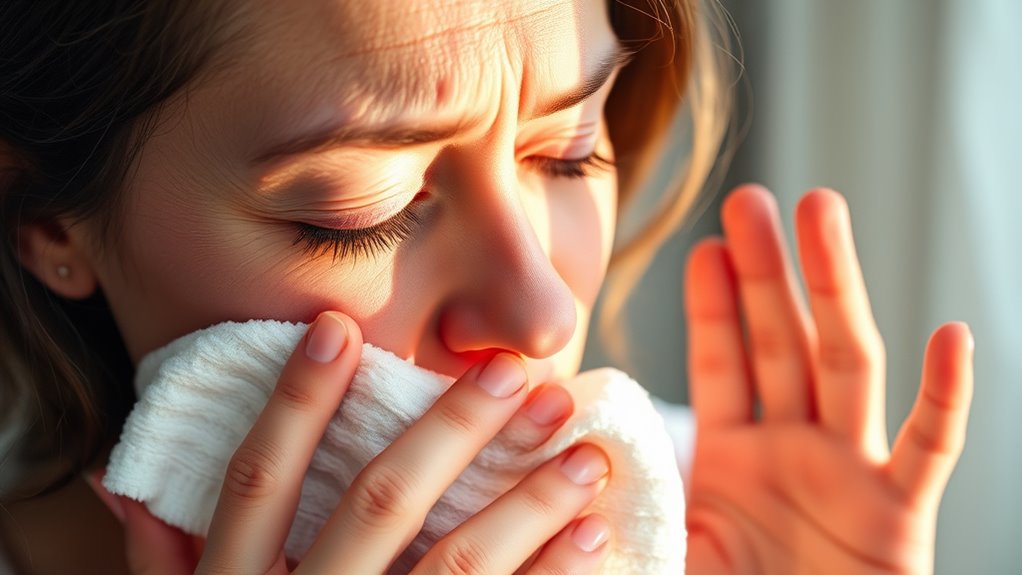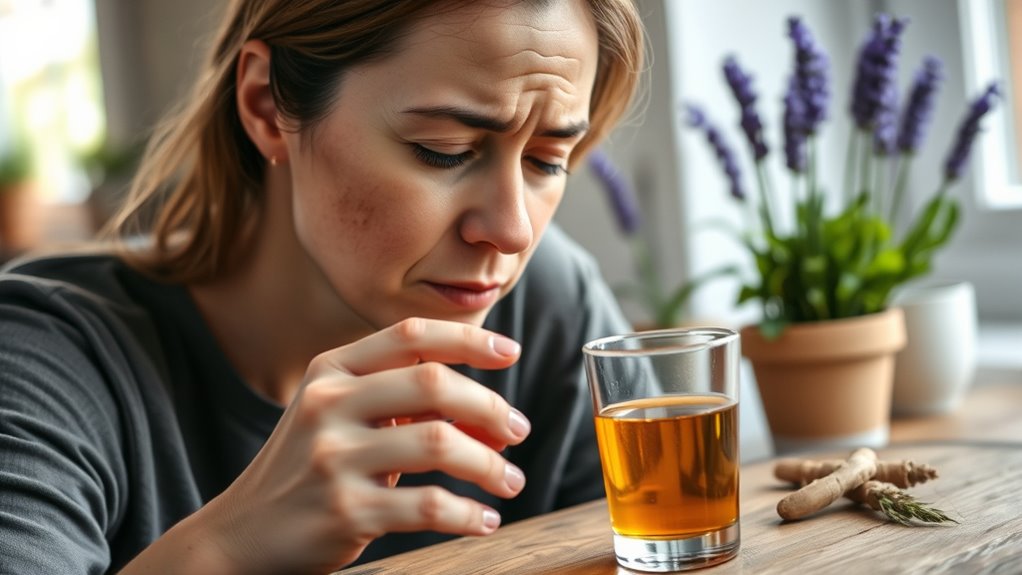Hot flashes are sudden feelings of intense heat, often during menopause, that can disrupt your sleep and daily life. They happen because hormonal fluctuations, especially decreased estrogen, cause your body to misjudge temperature, triggering sweating and flushing. Triggers include spicy foods, stress, caffeine, and alcohol. To manage them, try lifestyle changes like dressing in layers, reducing triggers, and exploring natural remedies such as herbal supplements. Discover more ways to stay comfortable and regain control over your well-being.
Key Takeaways
- Hot flashes are sudden feelings of intense heat, often with sweating and flushing, caused by hormonal fluctuations affecting temperature regulation.
- Lifestyle changes like stress management, wearing breathable clothing, and avoiding triggers can help reduce hot flash frequency.
- Natural remedies such as red clover and black cohosh may alleviate symptoms by acting as plant-based estrogen sources.
- Relaxation techniques like meditation, acupuncture, and yoga support overall well-being and may lessen hot flash severity.
- Maintaining a cool sleep environment and practicing good sleep hygiene can improve night sweat symptoms during menopause.
What Are Hot Flashes? Symptoms and Characteristics

Hot flashes are sudden episodes of intense heat that can catch you off guard, often accompanied by sweating, flushing, and a feeling of internal warmth. They typically affect your face, neck, and chest, causing your skin to turn red and hot. These episodes are classified as vasomotor symptoms (VMS) and are common during perimenopause and menopause, impacting over two-thirds of women. Hot flashes can last from a few minutes up to an hour and happen unpredictably. You might notice chills afterward due to excessive heat loss, and some experience feelings of anxiety or discomfort. These episodes are episodic and vary in frequency. They can disrupt your sleep, interfere with daily activities, and affect your overall well-being. Hot flashes are a significant part of menopause for many women. Research indicates that hormonal fluctuations and lifestyle factors can influence their intensity and frequency. Additionally, adopting certain lifestyle modifications and natural remedies may help manage the symptoms effectively, such as herbal supplements or dietary changes.
Causes and How Hormones Influence Hot Flashes

Hormonal changes, especially fluctuations in estrogen levels, play a central role in triggering hot flashes. When estrogen drops, it narrows your thermoneutral zone, making your body more sensitive to temperature shifts. This hormonal shift causes your hypothalamus—the brain’s thermostat—to misinterpret normal temperature signals, leading to a feeling of overheating. Additionally, decreased estrogen influences the release of other hormones, like luteinizing hormone (LH), which are linked to hot flashes, though not solely responsible. The activation of your sympathetic nervous system further narrows this zone, intensifying hot flashes and causing vasodilation and sweating. While estrogen depletion is key, hormonal fluctuations and nervous system responses together disrupt your body’s temperature regulation, creating the familiar hot flash episodes. Understanding hormonal regulation helps explain how these physiological changes contribute to hot flashes. Moreover, research suggests that hormonal fluctuations can also impact other bodily systems, amplifying the frequency and severity of hot flashes. Recognizing the role of hormonal balance is essential for developing effective management strategies. In addition, climate control technologies can help mitigate discomfort during hot flashes by maintaining a stable indoor environment. Additionally, some studies indicate that lifestyle factors like diet and stress can influence hormonal stability, potentially affecting hot flash occurrence.
Factors That Increase Risk and Common Triggers

Several factors can increase your risk of experiencing hot flashes, making some women more susceptible than others. If you smoke, you’re more likely to have hot flashes, as smoking affects hormone regulation. Being overweight or obese also raises the chances of frequent hot flashes. Ethnicity plays a role too; Black women often report more hot flashes than women of other backgrounds. Menopausal stage influences risk, with hot flashes common across different phases. Lower education levels may be linked to higher prevalence, possibly due to limited access to health resources. Triggers like emotional stress, spicy foods, caffeine, and alcohol can provoke hot flashes. Sudden temperature changes and certain medications also act as triggers. Understanding these factors helps you identify and manage your risk more effectively.
How Often Do Hot Flashes Occur and Their Duration

The frequency of hot flashes varies widely among women, ranging from a few episodes each week to dozens daily. Some women experience them sporadically, while others endure multiple episodes every day. Up to 10% face more than seven hot flashes daily, and in severe cases, 20–30 occur per day, often disrupting life and sleep.
Consider these facts:
- Hot flashes usually last between one and five minutes, with some episodes ending in under a minute.
- They start suddenly and can be intense, but most resolve quickly.
- The overall duration of experiencing hot flashes can span over a decade, especially if they begin early.
Your experience will be unique, but understanding these patterns can help you manage expectations and seek relief.
Lifestyle Changes and Natural Strategies for Management

Making simple lifestyle changes can considerably reduce hot flashes. By adjusting your diet, managing stress, and modifying your environment, you can better control your symptoms. These natural strategies empower you to feel more comfortable and in charge of your well-being. Incorporating nutrient-rich juices like spinach juice or citrus fruits can also support your overall health and help manage symptoms effectively.
Dietary Adjustments for Relief
Adjusting your diet can considerably reduce hot flashes by focusing on foods that support hormonal balance and overall health. Incorporating plant-based foods like soy, which contains isoflavones mimicking estrogen, can cut hot flashes by over 25%. Whole grains, vegetables, and fruits are staples that lower symptom severity. The Mediterranean diet, rich in fruits, vegetables, nuts, and healthy oils, has been linked to a 20% reduction in hot flashes. To optimize relief:
- Prioritize soy-based foods like tofu, edamame, and soy milk over supplements.
- Embrace a Mediterranean-style eating pattern for balanced nutrients.
- Limit processed foods, spicy dishes, caffeine, and alcohol to reduce triggers.
- Engaging in dynamic communication exercises with your healthcare provider or support network can further enhance your management strategies. Regular consumption of foods rich in phytoestrogens can also support hormonal regulation and mitigate symptoms. Incorporating nutrient-dense foods can further support overall health and hormone balance. Consuming a variety of colorful fruits and vegetables ensures diverse phytonutrient intake, which can bolster your body’s natural defenses against hormonal fluctuations. Additionally, practicing self-understanding through mindfulness or reflection can help you better identify and manage individual triggers and responses to hot flashes. These dietary adjustments support hormonal regulation, boost overall health, and can significantly ease hot flashes naturally.
Stress Management Techniques
Managing hot flashes effectively involves more than just dietary changes; controlling stress plays a significant role in reducing their frequency and severity. Techniques like mindfulness-based stress reduction (MBSR) help create psychological distance from hot flashes, reducing their bother. Cognitive-behavioral therapy can change thought patterns that worsen stress, while hypnotherapy may lower hot flash frequency and intensity. Meditation and deep breathing offer quick relief and help lessen hot flash impact. Practices like yoga and Tai Chi improve overall well-being and stress resilience. Incorporating lifestyle changes such as nature walks, regular exercise, and good sleep hygiene can further reduce stress. Natural strategies like acupuncture, massage, and guided imagery also promote relaxation. Using these techniques can make a noticeable difference in managing hot flashes and enhancing your quality of life. Additionally, understanding Paint Sprayer Reviews & Buying Guides can help you choose effective tools for home improvement projects that may contribute to a more relaxing environment. Embracing mindfulness techniques rooted in personal development principles can further empower you to handle stress more effectively and improve your overall well-being. Developing a consistent self-care routine that includes stress reduction methods can significantly impact the severity of hot flashes and overall health. Recognizing the importance of security vulnerabilities in stress management tools can help ensure your methods are both safe and effective. Incorporating regional health resources might provide additional support tailored to your specific needs.
Environmental and Lifestyle Modifications
Environmental and lifestyle modifications play a crucial role in reducing hot flashes by creating a cooler, more comfortable surroundings and avoiding common triggers. You can take simple steps to keep your body temperature in check and minimize discomfort. Wearing loose, lightweight clothing and dressing in layers so you can cool down quickly when needed helps manage sudden temperature changes. Keep your bedroom at around 65°F (18°C) and use fans or air conditioning to prevent night sweats. Limiting spicy foods, hot drinks, alcohol, and caffeine, especially before bedtime, can significantly reduce the frequency of hot flashes. Staying well-hydrated with cool water and choosing breathable bedding can also help. Additionally, organizing your space to reduce clutter and create a calming environment can contribute to overall stress reduction, which may lessen hot flash severity. Creating a stress-reducing environment can further help manage symptoms. Incorporating comfortable fabrics into your wardrobe and home environment can further enhance your comfort during hot flashes. Maintaining a balanced body temperature through environmental adjustments can be a simple yet effective strategy. Using natural remedies and air-purifying plants like snake plants or pothos can improve indoor air quality, which may help alleviate symptoms. These natural strategies empower you to manage hot flashes effectively without medication, improving your comfort and quality of life.
Complementary Approaches and Additional Natural Remedies

You can explore various complementary approaches and natural remedies to manage hot flashes, including herbal supplements like black cohosh, flaxseed, and soy isoflavones. Acupuncture also shows some promising evidence for symptom relief, though results vary. Additionally, adopting sleep and lifestyle tips can enhance your overall comfort and help reduce hot flash frequency. Incorporating Glycolic acid benefits for skin into skincare routines may improve skin health, which can contribute to overall well-being during menopause.
Herbal Supplements Options
Herbal supplements offer a natural approach to alleviating hot flashes and menopausal symptoms, providing alternatives or complements to conventional hormone therapy. These options can help you manage symptoms safely while supporting your overall well-being.
- Red Clover: Rich in isoflavones, it acts as a plant-based estrogen, potentially reducing hot flash frequency and severity without permanently affecting your hormones.
- Black Cohosh: Believed to balance estrogen levels and ease hot flashes, it may also improve mood and sleep, offering relief without significant side effects.
- St. John’s Wort: Known for its mood-enhancing properties, it can decrease hot flashes and combat menopause-related depression, but watch for medication interactions.
Always consult your healthcare provider before starting any herbal supplement to guarantee safety and appropriateness.
Acupuncture Effectiveness Evidence
Evidence on acupuncture’s effectiveness for hot flashes presents a complex picture. While some randomized trials show improvements compared to no treatment, many find no significant difference between true and sham acupuncture, largely due to placebo effects. This complicates confirming specific benefits. Some studies report reductions in hot flash frequency and severity, with improvements lasting up to three months. Here’s a summary:
| Study Type | Findings | Notes |
|---|---|---|
| Randomized Controlled Trials | Improvement over no treatment | Similar results in sham groups, indicating placebo influence |
| Meta-Analyses | Moderate benefit (-0.35 to -0.44) | Quality of life benefits mainly in vasomotor domain |
| Specific Populations | Benefits for women with breast cancer | Safe and well-tolerated, especially when medications are unsuitable |
| Clinical Setting | Widely practiced, increasing evidence | Effects often comparable to sham, highlighting placebo role |
Sleep and Lifestyle Tips
Implementing effective sleep and lifestyle strategies can substantially reduce hot flash frequency and improve overall sleep quality during menopause. Small changes can make a big difference.
- Keep your sleeping environment cool with fans or breathable bedding, and wear lightweight, layered clothing to adjust to temperature swings easily.
- Establish a calming pre-sleep routine—try reading or meditation—to help your body wind down and reduce stress.
- Avoid heavy meals, caffeine, and alcohol in the evening, and steer clear of exercise right before bed to prevent overheating and hot flashes that wake you.
Frequently Asked Questions
Can Hot Flashes Occur During Pregnancy or Postpartum Periods?
Yes, hot flashes can happen during pregnancy and postpartum. You might notice sweating, flushing, or chills, especially around week 30 of pregnancy or about two weeks after delivery. These symptoms result from hormonal fluctuations, like changes in progesterone and estrogen. They’re usually temporary, but if hot flashes are severe or come with other symptoms, you should talk to your healthcare provider to rule out other conditions.
Are Hot Flashes a Sign of Underlying Medical Conditions?
Hot flashes can sometimes signal underlying medical issues, not just menopause. If you experience hot flashes alongside symptoms like weight changes, fever, or palpitations, it’s essential to see a healthcare provider. They’ll evaluate your history, perform tests, and check for conditions like thyroid problems, infections, or reactions to medications. Don’t ignore persistent hot flashes—they might be your body’s way of alerting you to a health concern needing attention.
How Do Medications Influence the Frequency of Hot Flashes?
Medications can markedly reduce hot flash frequency. Estrogen therapy is the most effective, lowering symptoms by about 75%. Non-hormonal options like gabapentin cut hot flashes by up to 54%, while SSRIs and SNRIs, such as fluoxetine and desvenlafaxine, also help, though less dramatically. You might experience side effects or dropout due to adverse reactions, but these medications generally improve hot flash frequency and severity with proper management.
Do Hot Flashes Affect Men, and if So, Why?
Yes, hot flashes do affect men, sometimes more than you might expect. You might think they’re just a woman’s issue, but in reality, up to 80% of men on hormone therapy experience them. Low testosterone levels, aging, and medical treatments like prostate cancer therapy cause these sudden, intense waves of heat. They can disrupt your day and mood, showing that hot flashes are a significant, often overlooked, part of men’s health struggles.
Can Lifestyle Changes Completely Eliminate Hot Flashes?
You might wonder if lifestyle changes can completely eliminate hot flashes. While adjustments like adopting a plant-based diet, managing stress, exercising regularly, and avoiding triggers can considerably reduce symptoms, they may not completely eliminate hot flashes for everyone. Everyone’s experience is different, but these strategies can improve your comfort and quality of life. Combining multiple approaches offers the best chance to minimize hot flashes effectively.
Conclusion
Understanding hot flashes is like steering a sudden summer storm—unpredictable but manageable. By recognizing symptoms, identifying triggers, and exploring natural remedies, you can find calmer waters ahead. Making simple lifestyle changes and trying complementary approaches can help you ride out these fiery waves. Remember, you’re the captain of your well-being, steering through the heat with knowledge and care. With patience and the right strategies, you’ll weather the storm and find your peaceful breeze again.









